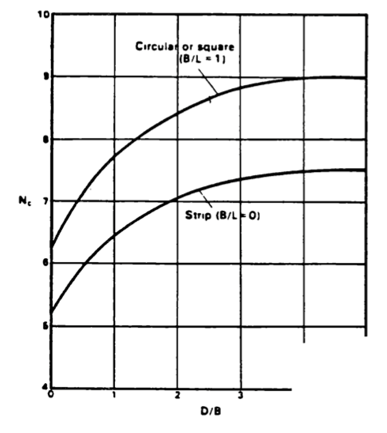Skempton Method (CPT)
This solution for cohesive soils use a Skempton theory, where the bearing capacity of foundation soil is given by a formula:
![]()
It is recommended to use a safety factor FS = 3 when calculating the bearing capacity using this method.
Where: | Rd | - | bearing capacity of foundation soil |
Kc | - | load inclination factor | |
Nc | - | Skempton bearing capacity factor | |
Su | - | undrained shear strength | |
γ | - | unit weight of the soil in the footing bottom | |
d | - | depth of the footing bottom |
The formula is derived for imperial units [tsf, tcf, ft] - the program calculates automatically in the units used in the program.
![]()
Where: | H | - | horizontal component of resultant load |
V | - | vertical component of resultant load |
This method should not be used for ratio H/V > 0,4.
Skempton bearing capacity factor Nc depends on the ratio of effective width bef and effective length lef and on the ratio of the footing bottom depth d and effective width bef.
 Determination of Nc factor (From Peck, Hanson a Thornburn, 1974)
Determination of Nc factor (From Peck, Hanson a Thornburn, 1974)
Undrained shear strength Su is determined as follows:
![]()
Where: | qc | - | average value of cone penetration resistance |
σv0 | - | average value of vertical stress measured at depths from footing base to 1,5.bef below the footing base | |
Nk | - | Cone factor (range <10;20>) |
![]()
Where: | qc1 | - | average value of cone penetration resistance measured at depths from footing base to 0,5.bef below the footing base |
qc2 | - | average value of cone penetration resistance measured from the depth 0,5.bef below the footing base to 1,5.bef below the footing base |
The influence of inclined terrain and inclined footing bottom is considered in the same way as in the Schmertmann method.
Literature:
FHWA-SA-91-043: THE CONE PENETROMETER TEST
Bridge Engineering Handbook (Wai-Fah Chen, Lian Duan, 1999)